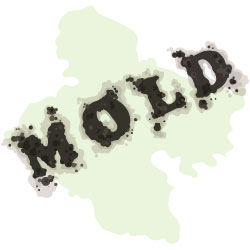Mold is a natural part of the environment, but it becomes a problem when it starts growing indoors. Indoor mold can be caused by a leak or improperly vented moisture-generating sources, such as bathrooms or dryers, and can cause allergic reactions, asthma and other respiratory issues.
Building practices during the 1970s – 1990s have been linked to some moisture problems due to tightly sealed buildings that lack adequate ventilation, which can cause moisture to build up. Areas that are frequently overlooked like ceilings, attics and crawl spaces should receive special attention after a leak.
Here are seven signs your building needs mold remediation:
- Allergy symptoms
If your employees, staff or visitors start to experience symptoms of an allergic reaction, such as skin irritation, breathing problems or congestion, mold may be at the root of the problem.
- Leaky pipes
All buildings have plumbing, but if your office, school or medical facility includes large and intricate water distribution systems, you may be more likely to have leaky pipes. Water problems that result from leaks are prime real estate for mold infestation. Bathroom areas should be consistently evaluated for water and plumbing leaks.
- Water stains
Water stains on the ceiling, walls or floor are telltale signs of mold growth as they provide a solid, moist surface on which mold can grow and expand.
- Strange smells
When mold infests a building, it emits a musty odor in areas where there is a large amount of moisture. If the smell persists, it’s time to contact a mold remediation service.
- Humidity
The only thing mold needs to survive is moisture, and humid environments make for ideal breeding grounds. According to the EPA, if your building has a relative humidity of more than 60 percent, it’s at an elevated risk for mold infestation.
- Ventilation issues
Insufficient ventilation can lead to excessive moisture and, potentially, mold. Furnace humidifiers and HVAC systems should be cleaned regularly to prevent mold and bacterial growth. Ducts and filters for humidifiers can become moldy and spread spores throughout your building.
- Spores
Mold spores, which appear as fuzzy or slimy discolorations on your building’s surfaces, indicate mold infestation and should be addressed immediately.
According to the U.S. Environmental Protection Agency (EPA), there’s no practical way to eliminate all the mold and mold spores in your office, school, or medical facility, but you can control the moisture causing mold to grow.
The EPA suggests the following tips to prevent mold from growing:
- Fix leaky plumbing and leaks in the building envelope as soon as possible.
- Watch for condensation and wet spots. Fix source(s) of moisture problem(s) as soon as possible.
- Prevent moisture due to condensation by increasing surface temperature or reducing the moisture level in air (humidity). To increase surface temperature, insulate or increase air circulation. To reduce the moisture level in air, repair leaks, increase ventilation (if outside air is cold and dry), or dehumidify (if outdoor air is warm and humid).
- Keep heating, ventilation and air conditioning (HVAC) drip pans clean, flowing properly and unobstructed.
- Vent moisture-generating appliances, such as dryers, to the outside where possible.
- Maintain low indoor humidity, below 60 percent relative humidity (RH), ideally 30 – 50 percent, if possible.
- Perform regular building/HVAC inspections and maintenance as scheduled.
- Clean and dry wet or damp spots within 48 hours.
- Don’t let foundations stay wet. Provide drainage and slope the ground away from the foundation.
To learn more about the mold remediation services offered through LCS Facility Group, call us today at 866-800-4LCS.

